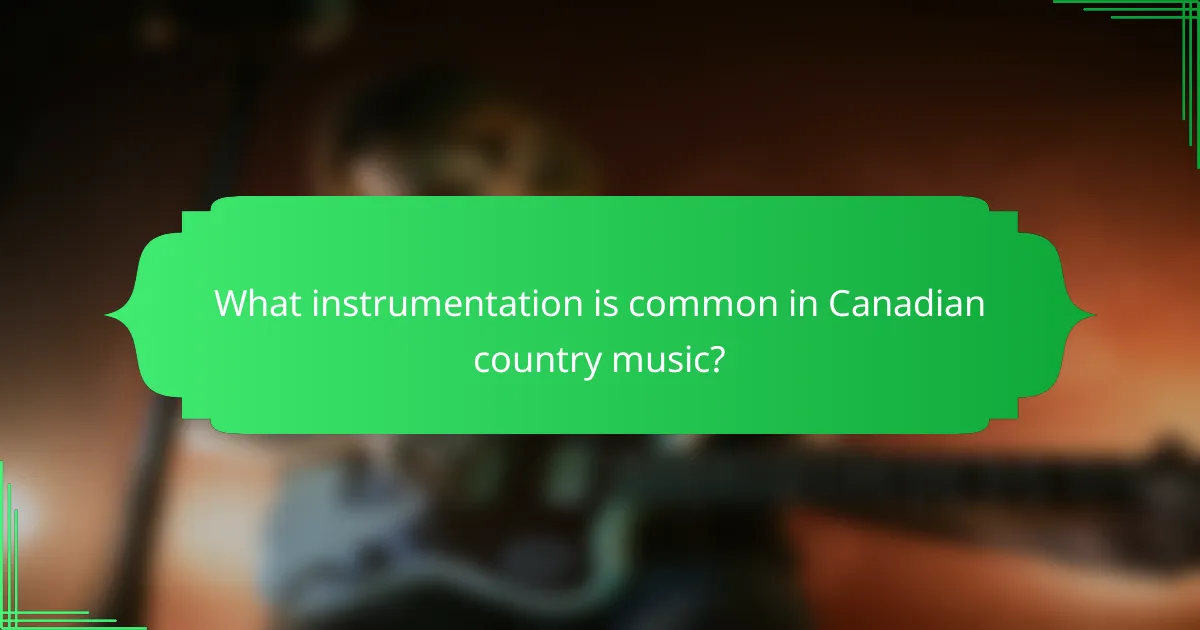Country music in Canada is a rich tapestry of storytelling that reflects the diverse experiences and backgrounds of its artists. Influenced by the country’s vast geography, each region contributes unique narratives and musical elements, while a blend of traditional and modern instrumentation enhances the genre’s emotional resonance. From the prairies to the East Coast, Canadian country music captures the essence of life through its distinctive sound and heartfelt tales.

How does storytelling shape country music in Canada?
Storytelling is a fundamental aspect of country music in Canada, reflecting the diverse experiences and backgrounds of its artists. Through personal narratives, cultural reflections, and emotional connections, Canadian country music captures the essence of life across various regions.
Personal narratives
Personal narratives in Canadian country music often draw from the artists’ own life experiences, creating relatable and authentic songs. These stories can range from tales of love and heartbreak to reflections on rural life and personal struggles. For example, a song might recount a childhood memory of growing up in the Prairies, evoking a sense of nostalgia and connection to the land.
Artists like Corb Lund and Kacey Musgraves exemplify this approach, using their backgrounds to craft songs that resonate with listeners. Their lyrics often include vivid imagery and specific details that bring their stories to life, making them accessible and engaging.
Cultural reflections
Country music in Canada serves as a mirror to the country’s rich cultural tapestry, incorporating elements from Indigenous, French, and English traditions. This blending of influences creates a unique sound that reflects the diverse communities across the nation. Songs may include references to local customs, historical events, or regional dialects, enriching the storytelling experience.
For instance, artists like Buffy Sainte-Marie have integrated Indigenous perspectives into their music, highlighting social issues and cultural pride. This cultural reflection not only informs the music but also fosters a greater understanding and appreciation of Canada’s multifaceted identity.
Emotional connections
Emotional connections are at the heart of storytelling in Canadian country music, allowing listeners to relate to the themes and experiences presented in the songs. The ability to convey deep feelings—whether joy, sorrow, or nostalgia—creates a bond between the artist and the audience. This connection is often enhanced by the use of relatable language and universal themes.
Many Canadian country songs evoke strong emotions through their melodies and lyrics, encouraging listeners to reflect on their own lives. For example, a song about loss may resonate with someone who has experienced a similar situation, fostering a sense of community and shared experience among fans.

What regional influences impact Canadian country music?
Canadian country music is shaped by diverse regional influences that reflect the country’s vast geography and cultural heritage. From the prairies to the East Coast, each area contributes unique storytelling styles, musical elements, and instrumentation that enrich the genre.
Prairie roots
The prairie provinces, including Alberta, Saskatchewan, and Manitoba, are known for their strong country music traditions, heavily influenced by folk and Western styles. Artists often draw inspiration from the rural landscape, incorporating themes of farming, love, and hardship into their lyrics.
Instrumentation typically features acoustic guitars, fiddles, and banjos, creating a sound that resonates with the agricultural lifestyle. Festivals like the Calgary Stampede showcase this prairie influence, attracting both local and international talent.
East Coast traditions
The East Coast, particularly Newfoundland and Nova Scotia, brings a distinct flavor to Canadian country music through its rich maritime culture. Traditional sea shanties and Celtic influences are prevalent, resulting in a unique blend of folk and country sounds.
Musicians often use instruments like the accordion and bodhran, which add a lively, rhythmic quality to their music. The East Coast music scene is vibrant, with events such as the Stan Rogers Folk Festival highlighting local artists and their storytelling prowess.
Indigenous contributions
Indigenous artists play a vital role in shaping Canadian country music, infusing it with their rich cultural narratives and musical traditions. Their contributions often reflect themes of identity, resilience, and connection to the land.
Instruments such as the drum and flute are commonly integrated into their music, creating a fusion of contemporary country with traditional Indigenous sounds. Collaborations between Indigenous and non-Indigenous artists are becoming more common, further enriching the genre and promoting cultural exchange.

What instrumentation is common in Canadian country music?
Canadian country music features a blend of traditional and modern instrumentation, with guitars, fiddles, banjos, and pedal steel guitars being particularly prominent. These instruments contribute to the genre’s storytelling and regional influences, creating a unique sound that resonates with audiences across Canada.
Guitar varieties
Guitars are central to Canadian country music, with both acoustic and electric varieties playing significant roles. Acoustic guitars often provide the foundation for storytelling through their warm, resonant tones, while electric guitars add a modern edge with their versatility in sound. Popular brands like Gibson and Fender are commonly used among Canadian artists, reflecting a mix of traditional and contemporary styles.
Fingerpicking and strumming techniques are frequently employed, allowing musicians to express a range of emotions. Artists may also use alternate tunings to achieve unique sounds that enhance their lyrical narratives.
Fiddle usage
The fiddle is a staple in Canadian country music, particularly in regions with strong folk traditions, such as the Maritimes and Alberta. Its lively sound adds a distinctive flair to songs, often accompanying vocals or other instruments. Fiddlers may incorporate various styles, from traditional jigs to modern interpretations, creating a rich tapestry of sound.
Collaborative performances often feature fiddlers alongside guitarists and other musicians, fostering a communal atmosphere that is characteristic of Canadian country music events. Learning to play the fiddle can be an accessible entry point for aspiring musicians, as many local communities offer lessons and workshops.
Banjo and pedal steel
Banjo and pedal steel guitars contribute to the unique sound of Canadian country music, adding depth and texture to compositions. The banjo, with its bright, twangy tone, is often used in upbeat songs and can create a lively rhythm that engages listeners. It is particularly popular in bluegrass-influenced country styles.
Pedal steel guitars, on the other hand, are known for their smooth, sliding notes that evoke a sense of longing or nostalgia. This instrument is frequently featured in ballads and slower songs, enhancing the emotional impact of the lyrics. Both instruments require specific techniques and practice, making them rewarding challenges for dedicated musicians.

How do Canadian artists incorporate local themes?
Canadian artists weave local themes into their music by drawing inspiration from the diverse landscapes, rich community narratives, and significant historical events unique to Canada. This approach not only reflects their cultural identity but also resonates with audiences who share similar experiences.
Landscapes and nature
Canadian country music often highlights the stunning natural beauty of the country, from the Rocky Mountains to the vast prairies. Artists may use vivid imagery to evoke feelings associated with specific locations, such as the tranquility of a lakeside or the ruggedness of a forest. This connection to nature can create a sense of place that is deeply relatable to listeners.
For example, songs may describe the changing seasons, capturing the essence of winter’s chill or summer’s warmth, which can resonate with listeners’ own experiences of these landscapes.
Community stories
Community stories play a vital role in Canadian country music, as artists often share tales of everyday life, struggles, and triumphs within their local communities. These narratives can range from personal anecdotes to collective experiences, reflecting the values and traditions of the people. This storytelling fosters a sense of belonging and connection among listeners.
Artists might highlight local events, festivals, or even challenges faced by their communities, creating a relatable and authentic sound that speaks to shared experiences.
Historical events
Historical events are frequently woven into the fabric of Canadian country music, with artists addressing themes such as immigration, cultural heritage, and significant national milestones. By referencing these events, musicians can evoke a sense of pride and reflection on the past, encouraging listeners to consider their own histories.
For instance, songs might commemorate pivotal moments in Canadian history or celebrate the contributions of various cultural groups, enriching the narrative landscape of the music and fostering a deeper understanding of the nation’s identity.

What are the key elements of songwriting in country music?
The key elements of songwriting in country music include a strong narrative structure, vivid imagery, and memorable hooks. These components work together to create relatable stories that resonate with listeners, often reflecting regional influences and personal experiences.
Verse-chorus structure
The verse-chorus structure is fundamental in country music, typically consisting of alternating verses and a repeated chorus. This format allows the songwriter to tell a story in the verses while emphasizing the main theme or emotion in the chorus. A common approach is to have two to three verses, each building on the narrative, followed by a catchy chorus that listeners can easily remember.
For example, many country songs feature a setup in the verses that leads to a climactic or emotional resolution in the chorus, creating a satisfying musical journey. This structure not only enhances the storytelling aspect but also makes the song more engaging for the audience.
Imagery and symbolism
Imagery and symbolism are crucial in country music, as they help paint vivid pictures that evoke emotions and connect with listeners. Songwriters often use descriptive language to create scenes that reflect personal experiences, landscapes, or cultural elements. Common symbols include rural settings, vehicles like trucks, and references to nature, which resonate with the genre’s audience.
Effective imagery can transport listeners to a specific moment or feeling, enhancing the overall impact of the song. For instance, mentioning a sunset over a field can symbolize hope or nostalgia, adding depth to the narrative.
Repetition and hooks
Repetition and hooks are essential tools in country songwriting, as they make songs memorable and engaging. A strong hook, often found in the chorus, captures the listener’s attention and reinforces the song’s main message. Repeating phrases or melodies can create a sense of familiarity, encouraging listeners to sing along.
When crafting hooks, songwriters should aim for simplicity and catchiness, often using relatable themes or emotions. Avoiding overly complex lyrics can help ensure that the hook resonates with a wide audience, making it more likely to become a favorite among fans.
